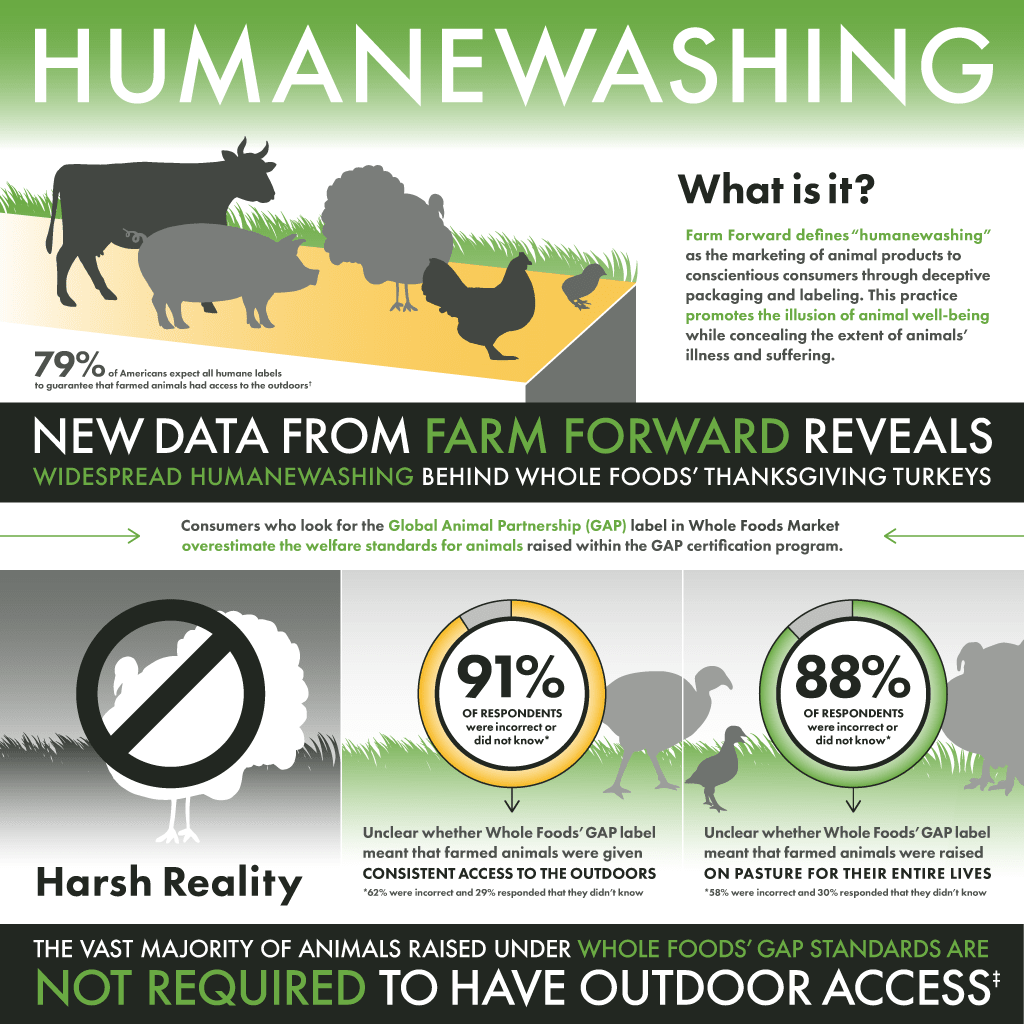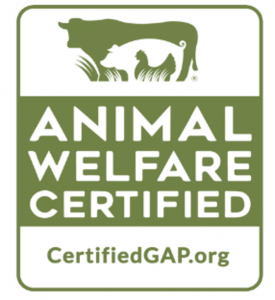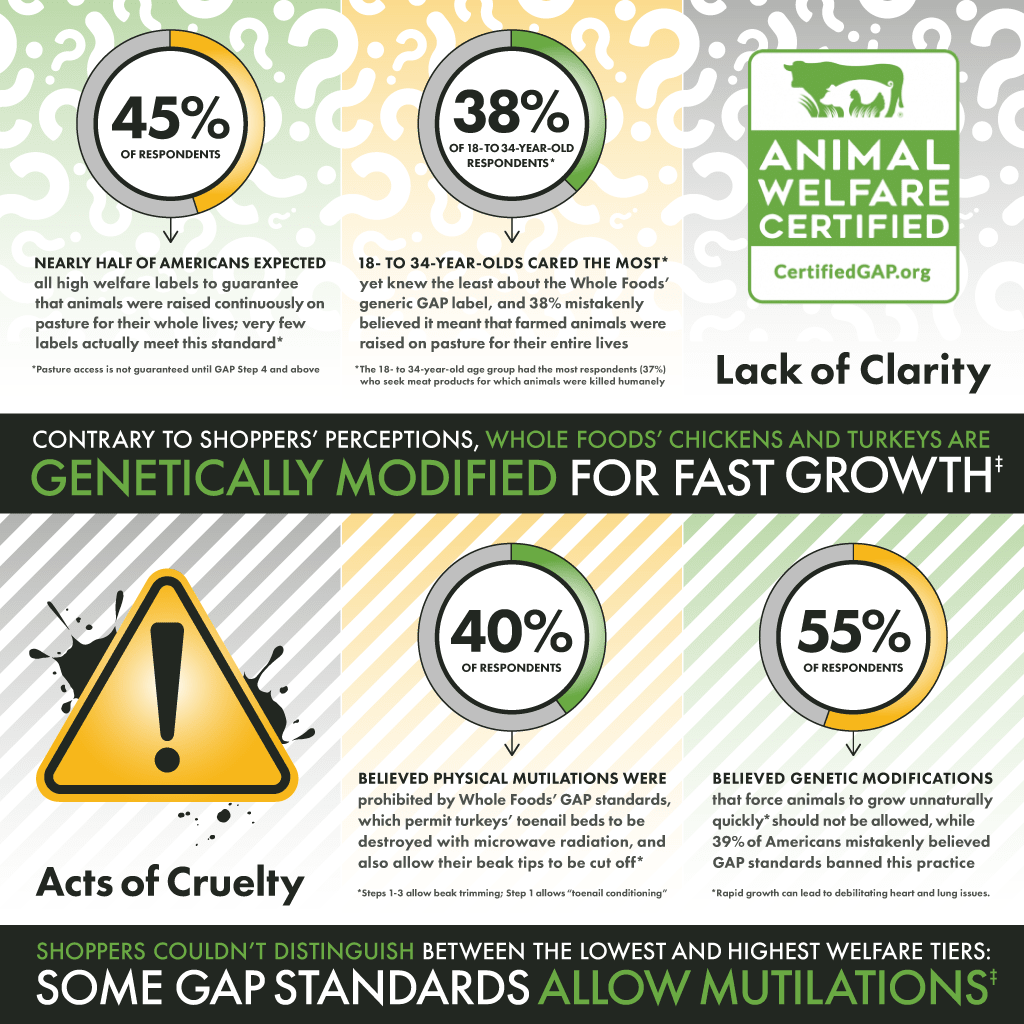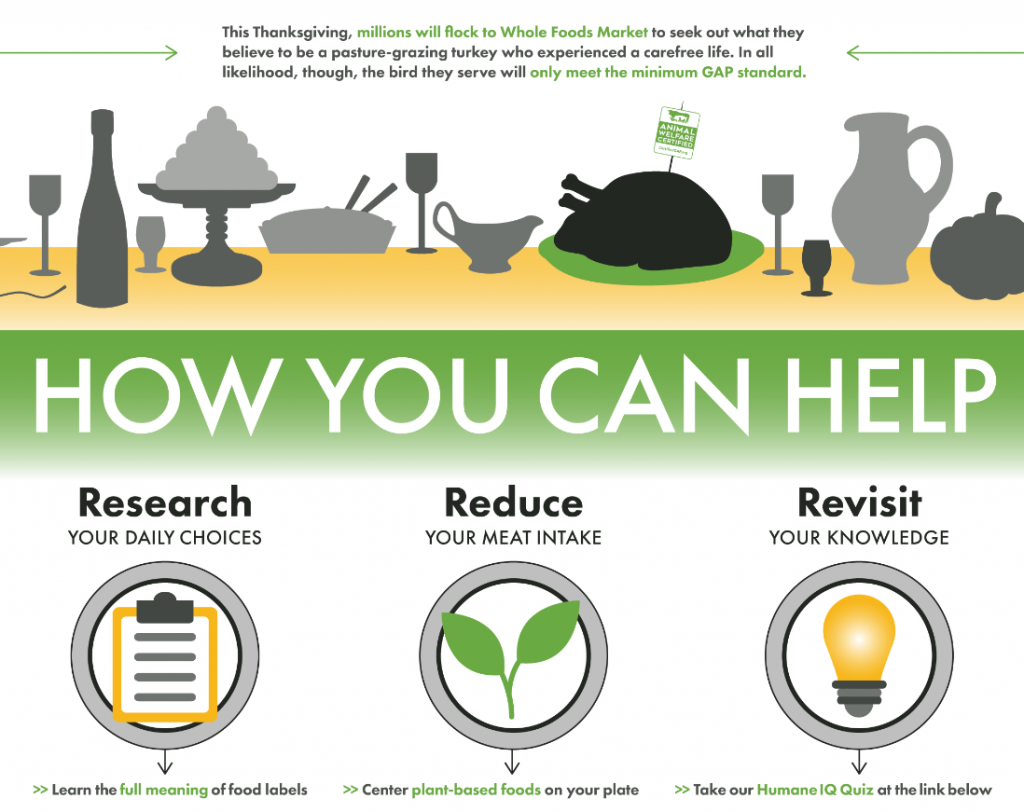Think You Can Find a Humanely Raised Turkey at Whole Foods for Thanksgiving? Think Again.
Every Thanksgiving Farm Forward is asked to help inform consumers about where to purchase a humanely raised turkey. For years we have tried our best to provide accurate and honest answers to these questions, relying on independent welfare certifications like Global Animal Partnership (GAP), the label that certifies meat at Whole Foods Market. This year, as we’ve deepened our investigation into the widespread practice of humanewashing, we realized that in order to responsibly educate consumers, we need to first understand the impact that certifications like Whole Foods’ GAP label have on shoppers.
We want to know:
- When shoppers buy meat with Whole Foods’ GAP label, do their expectations match the reality of how those animals were raised?
- Does Whole Foods’ GAP label make shoppers better informed, or more confused, about animal welfare practices?
These are questions Farm Forward sought to answer in a survey we commissioned this September.1 What we learned is that very few Americans (9 to 11 percent) understand what GAP certification labels mean, with 40 percent believing that the labels indicate better welfare practices than they actually do.
This confusion benefits the lowest welfare meat producers at the expense of the highest welfare meat producers. Moreover, a “halo effect” of top brands benefits not only the worst producers at Whole Foods, but also brands at other retailers that use bogus labels and sham certifications on their meat products. The outcome is that consumers are confused and mistrustful of labels and can’t make good choices when it comes to purchasing high welfare animal products, even at trusted retailers like Whole Foods.
 Download the full infographic, here.
Download the full infographic, here.
The Data Shows: Whole Foods Customers Do Not Know What They Are Buying
Many consumers looking for a humanely raised turkey this Thanksgiving will go to Whole Foods and pay more than they would at a conventional supermarket, and with good reason: all products sold through Whole Foods’ meat counters are certified by GAP, the largest independent animal welfare certification in the US.2
So, are Whole Foods customers who care about animal welfare getting what they believe they pay for? That depends on what they believe the GAP labels on Whole Foods meat actually means.
When shown an image of Whole Foods’ generic GAP label,3 Americans were asked if they agreed or disagreed with statements about how animals certified under this label were actually raised.
 Generic GAP label found on meat at Whole Foods
Generic GAP label found on meat at Whole Foods
They responded as follows:
- 33 percent agree the GAP label means animals were raised their whole lives on a pasture.
- 39 percent agree the GAP label means animals were given consistent access to the outdoors.
- 40 percent agree the GAP label means animals were subjected to no physical modifications by humans (e.g. no removal of cows’ horns).
- 40 percent agree the GAP label means animals were raised on a farm/pasture that exceeds minimum environmental standards.
- 39 percent agree the GAP label means animals were not genetically modified to grow unnaturally large/quickly.4
Only 9 to 11 percent of respondents disagreed with these statements, suggesting that only a small minority understand that this generic label doesn’t necessarily mean that animals are raised on pasture, given consistent access to the outdoors, spared from painful procedures that are the norm on factory farms, or not genetically modified for fast growth.
Advocates for GAP and other independent animal welfare certifications will say that these certifications, even at their lowest tiers, do mandate welfare conditions on farms that are better than those on most uncertified farms, and that’s true. When it comes to animal welfare, GAP-certified products are likely somewhat better than the very worst meat products in America.
But these Whole Foods suppliers still raise animals on factory farms, and under conditions that customers broadly consider to be inhumane. Notably, regardless of what they thought animal welfare certifications actually meant, 45 percent of survey respondents agreed with this statement: “Any label that certifies high animal welfare needs to ensure that animals are raised continuously on a pasture.” Only 11 percent of respondents disagreed.

The “Halo Effect” Benefits the Worst Welfare Suppliers
Supporters of GAP will also tell you that some GAP producers raise animals under some of the best welfare conditions in America—on pasture, with better genetics, and more—and that the Step system offers guidance for consumers about which of its farms achieve these high marks. This is also true. Products certified at GAP Steps 5 and 5+ feature most or all of the positive welfare conditions mentioned in our survey. However, the survey also found that many consumers may not be able to distinguish between lower and higher Step labels.
When we created our survey, Farm Forward’s hypothesis was that, due in part to deceptive marketing of GAP and Whole Foods products, many shoppers may assume that the top tiers of GAP are the norm for all GAP-certified products.

Three recent examples taken from GAP’s Twitter feed. Last accessed November 9, 2021.
GAP adorns its generic certification label with bucolic imagery despite the fact that its GAP Step 5 and 5+ products are the only Steps in the program even close to achieving that expectation, and they are the rarest products you can find—many Whole Foods stores don’t carry any Step 5 or 5+ poultry products. The majority of poultry products lining Whole Foods’ store shelves are certified to Steps 1 and 2 which, despite marketing efforts to persuade us otherwise, are factory farms modified only slightly, where the birds may not even have consistent access to the outdoors.
Historically, all GAP-certified products had to be labeled with the specific Step to which each product was certified. In other words, if a product was certified to Step 1, each package was required to feature a label indicating that the product was certified to GAP’s Step 1 standards. The generic certification label shown above, which omits details about the Step to which the product has been certified, was created more recently, and producers can now opt into using this generic label instead of displaying their specific Step. By making the Steps more difficult to distinguish at the point of sale, GAP has created a loophole through which lowest welfare producers benefit from the “halo effect” of GAP’s highest tiers. Unsurprisingly, the generic label has become a popular choice among Whole Foods’ lowest welfare suppliers.
Retailers like Whole Foods and the brands they carry profit from the halo of GAP’s highest welfare farms because customers are willing to pay more for products that meet these expectations. Would shoppers pay the same premium prices if they understood that many products on Whole Foods’ shelves come from only marginally better factory farms?
Conclusions: Whole Foods Customers Have Good Reason to Feel Deceived
Whole Foods and other retailers give the impression that animal welfare certifications help their customers identify products that best align with their values. However, the results of our survey suggest that these certifications cause confusion and create mistrust: 39 percent of survey respondents agreed with the statement, “I get confused by the different animal welfare labels,” and 48 percent agreed with the statement, “I don’t believe food certifications are completely honest.”
All animal welfare labels, even independent certifications like GAP, have features that are designed to confuse and mislead consumers into believing that conditions on farms are better than they truly are; GAP’s generic label, which obscures the nuances of their once-progressive Step system, is just one example.6 Unlike GAP, which despite its deceptive marketing tactics is among the most rigorous and legitimate animal welfare certifications, many certifications, including United Egg Producers Certified and One Health Certified (OHC), were created by the meat industry for the sole purpose of assuaging consumers’ fears about conditions on factory farms without improving welfare standards.
But according to the results of our survey, many shoppers are unable to distinguish between independent certifications, like GAP, and industry marketing tools, like OHC—a deceptive certification created by one of the country’s largest chicken producers, Mountaire. When survey respondents were shown images of OHC and generic GAP labels, a similar percentage agreed with statements that the labels ensure animals are raised on pasture.7 These results raise serious questions about whether independent and well-intentioned animal welfare certifications do more harm than good in the absence of regulation and consumer education.

See the results of the survey here and our factsheet here.
In past years, Farm Forward has recommended Whole Foods and GAP among sources of higher welfare turkeys for Thanksgiving. But Whole Foods customers clearly want and expect better than they may be getting, so we can no longer recommend them.
Our survey revealed that when shoppers buy GAP-certified products from Whole Foods they imagine an animal who was raised on pasture, not on a factory farm. But very few of the turkeys sold at Whole Foods actually meet that expectation, even though customers are paying premium prices for them. And if that reality is too unpleasant for shoppers to stomach, Whole Foods should take factory farmed products off its shelves.
How well do you understand animal welfare labels? Join the thousands of others taking the quiz this season, and share your results!
Endnotes
1.
Farm Forward conducted an online survey through YouGov, September 3-7, 2021. The total sample size was 1,219 adults. The figures have been weighted and are representative of all U.S. adults (aged 18+).
2.
We distinguish independent certifications that provide third-party oversight of welfare practices from industry-owned labels that provide no meaningful welfare benefits. See our white paper, “The Dirt on Humanewashing,” for more on the differences between independent and industry-run animal welfare certifications.
3.
GAP calls this label their “base certification.” Unlike other labels, this generic certification mark does not include a Step number or details about the corresponding welfare standards.
4.
While farmed animals are not “genetically engineered” in the sense that traits from one species are crossed with traits from another species, hyper-intensive breeding techniques have created a number of dramatic changes to the physiology and morphology of contemporary farmed animals. Visit our blog post about “hybrid poultry” to learn more.
5.
A small percentage of Whole Foods’ meat products are certified to more stringent GAP standards, Steps 4-5+, which do require better conditions for animals, like being raised on pasture. However, the more ubiquitous generic GAP label only requires that GAP Step 1 standards are met.
6.
Read more about these deceptive tactics in our blog post about Farm Forward’s resignation from GAP’s board of directors.
7.
Learn more about Farm Forward’s campaign against One Health Certified here.